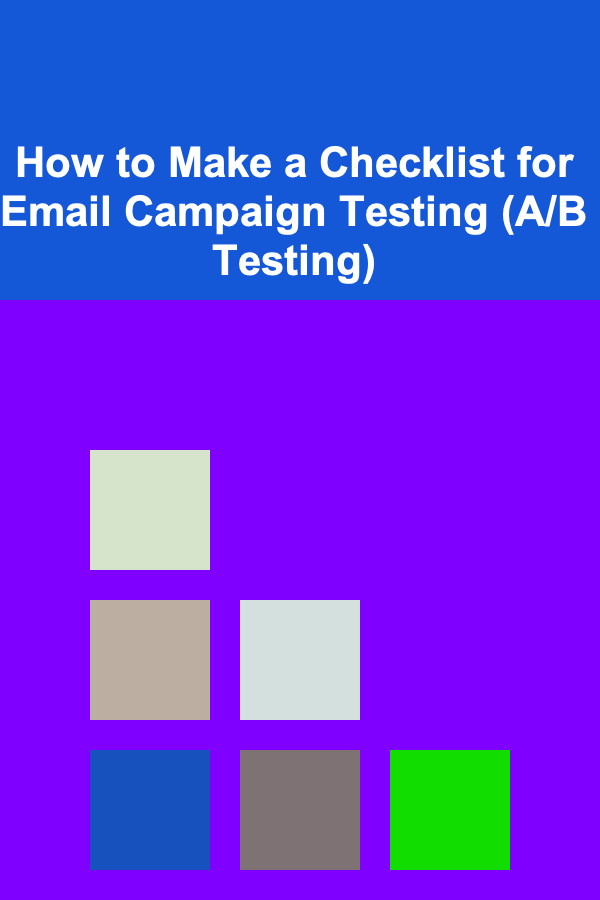
How to Make a Checklist for Email Campaign Testing (A/B Testing)
ebook include PDF & Audio bundle (Micro Guide)
$12.99$9.99
Limited Time Offer! Order within the next:

Email marketing is a powerful tool for engaging customers, nurturing leads, and driving sales. However, to truly optimize your email campaigns, you need to go beyond just sending emails and start testing their effectiveness. This is where A/B testing comes into play. By testing different versions of your emails, you can gain valuable insights into what resonates most with your audience and make data-driven decisions to improve your email performance.
In this guide, we'll walk you through how to create an actionable checklist for email campaign A/B testing. This checklist will ensure you're covering all the essential elements to make your tests effective, meaningful, and insightful.
Define Your Objective
Before diving into any A/B test, it's crucial to clearly define what you are trying to achieve with your email campaign. Having a well-defined objective helps you choose the right variables to test and ensures your testing process remains focused and purposeful.
Key Considerations:
- Conversion Goals: Are you testing for increased open rates, click-through rates (CTR), conversion rates, or engagement?
- Target Action: What do you want the reader to do? For example, click a link, reply to the email, make a purchase, or subscribe to a service.
- Metric of Success: Decide on how you'll measure success for the campaign, whether it's through raw numbers or percentages.
Example:
Objective: Increase the open rate by testing different subject lines.
Choose the Elements to Test
Once your objective is clear, you need to decide which elements of the email campaign you will test. A/B testing involves comparing two (or more) versions of an email, where only one variable differs between the versions.
Elements to Consider Testing:
-
Subject Line: The subject line is the first impression of your email, and it plays a crucial role in whether your email gets opened. Test different subject lines to determine which one results in a higher open rate.
- Examples: Length of subject line, emotional vs. informative tone, use of urgency, personalization.
-
Sender Name: Sometimes, a recognizable sender can increase open rates. Test sending from a brand name versus an individual's name or a combination.
-
Email Copy: The message inside the email is arguably the most important element. Testing different copy variations can help you find what works best in terms of engagement and conversion.
- Examples: Length of the email, tone of voice (formal vs. casual), inclusion of testimonials or social proof.
-
Call to Action (CTA): The CTA is the key to driving the desired action. Test different CTA texts, designs, and placements within the email.
- Examples: "Buy Now" vs. "Learn More", CTA placement (above or below the fold), CTA button color.
-
Email Design/Layout: Visual elements matter. Experiment with variations in the layout to determine which design drives the most interaction.
- Examples: Single-column vs. multi-column design, image-heavy vs. text-heavy layout, color schemes.
-
Personalization: Personalizing an email can lead to higher engagement. Test personalized elements like including the recipient's name in the subject line or body of the email.
-
Send Time and Frequency: Timing can have a huge impact on email performance. Test sending at different times of day or days of the week, as well as the frequency of your email sends.
-
Segmentation: Test how different segments of your audience respond to various email versions. For example, compare responses from new subscribers vs. long-term customers.
Create Two Versions (A/B Versions)
Once you've decided which element you want to test, create two distinct versions (A and B). These versions should be identical except for the single element you're testing. This ensures that any differences in performance can be attributed to the tested element rather than other factors.
Important Guidelines:
- Control Group (A): This is the original version of your email, which will act as the benchmark.
- Variation Group (B): This is the modified version with the change you are testing.
- Ensure that the changes between versions are measurable. For example, if you are testing subject lines, ensure the rest of the email remains the same for both versions.
Define Your Sample Size
A/B testing is most effective when you have a sufficient sample size to draw statistically significant conclusions. If your sample size is too small, the results may be skewed or inconclusive.
How to Determine Your Sample Size:
- Consider Your Email List Size: If you have a large list, you may need fewer recipients per test, while smaller lists may require more recipients per variation.
- Statistical Significance: Use an online sample size calculator to determine the appropriate sample size needed for your test, considering the level of confidence you want (usually 95% confidence level).
- Split Your List: Divide your audience into two random groups. If you're testing more than one element, you may need more groups, but it's crucial to ensure that the testing is fair and unbiased.
Set the Test Duration
Set a time frame for your test. It's important not to test for too short a time, as results may not be accurate or representative. Likewise, testing for too long can delay decision-making without providing substantial additional insights.
Considerations for Test Duration:
- Avoid Seasonality: Ensure the test period doesn't overlap with major events or seasonal changes that could skew your results.
- Minimum Duration: A good minimum duration for an A/B test is 3 to 7 days to account for differences in open and click-through rates based on timing.
- Traffic Volume: Ensure enough traffic is generated during the test period to get statistically valid results.
Measure the Results
Once your A/B test has concluded, it's time to measure the results and compare the performance of both versions. Make sure you track all relevant metrics based on your test objective.
Key Metrics to Track:
- Open Rate: This shows how effective your subject lines or sender names were.
- Click-Through Rate (CTR): Measures how well your email copy, CTA, or design performed.
- Conversion Rate: This is critical for tracking the ultimate goal of the email, such as a purchase or sign-up.
- Engagement Metrics: Metrics like reply rates or social media shares can provide additional insights into your audience's engagement.
Analyze and Apply Findings
Once you've gathered the data, compare the performance of the two versions. Based on your analysis, determine which variation was more successful in achieving your defined goal.
Steps to Analyze:
- Statistical Significance: Ensure that your results are statistically significant. If the difference in performance is not statistically significant, the test results may not be reliable.
- Winning Version: If one version outperforms the other, implement that version in your future email campaigns.
- Iterate and Optimize: A/B testing is a continuous process. Use the insights gained from one test to inform future tests. For instance, if a certain CTA style worked well, try testing it in different contexts or combinations.
Document and Repeat
Document the results of each A/B test, noting what worked, what didn't, and why. This helps build a knowledge base that you can refer to in future campaigns. By continuously testing and iterating, you can steadily improve the effectiveness of your email marketing strategy.
Keep in Mind:
- Test One Element at a Time: This ensures the results are attributable to the variable you're testing.
- Test Regularly: Email marketing trends and consumer behavior can evolve, so regular testing ensures you stay up-to-date with what works best.
- Use Automation Tools: Leverage email marketing software to automate A/B testing, track results, and optimize campaigns at scale.
Conclusion
Creating a checklist for email campaign testing (A/B testing) ensures you stay organized and focused throughout the testing process. From defining your objectives and selecting elements to test to analyzing the results and applying findings, each step plays a crucial role in optimizing your email marketing strategy. By following a structured approach to A/B testing, you'll be able to continuously improve your email campaigns, increase engagement, and drive more conversions over time.
Reading More From Our Other Websites
- [Organization Tip 101] How to Create a Home Management Binder for Organization
- [Organization Tip 101] How to Set Up an Art Supply Station for Kids
- [Skydiving Tip 101] Preparing Your Body for the Drop: Pre-Skydiving Health Best Practices
- [Biking 101] How to Improve Your Bike Safety: Essential Tips for Riders
- [Personal Investment 101] Top Passive Income Opportunities for Deep Learning Enthusiasts
- [Home Budget 101] How to Budget for Hobbies Without Breaking the Bank
- [Home Budget 101] How to Cut Down on Dining Out and Save for Your Home Budget
- [Soap Making Tip 101] Conquering Common Soap-Making Mishaps: A Beginner's Survival Guide
- [Horseback Riding Tip 101] Essential Horseback Riding Tips for Beginners
- [Home Lighting 101] How to Maximize Lighting in Small Spaces for a Brighter Home

How to Color-Code Your Cooking Utensils for Easy Identification
Read More
How to Monetize Deep Learning Projects and Earn Long-Term Income
Read More
How to Renovate Your Home for a Family-Friendly Layout
Read More
How to Soundproof Your Home Against Noise from Nearby Schools
Read More
How to Create a Coaching Planner System for Group Coaching
Read More
10 Tips for Managing RSVP Responses on Your Wedding Guest List
Read MoreOther Products

How to Color-Code Your Cooking Utensils for Easy Identification
Read More
How to Monetize Deep Learning Projects and Earn Long-Term Income
Read More
How to Renovate Your Home for a Family-Friendly Layout
Read More
How to Soundproof Your Home Against Noise from Nearby Schools
Read More
How to Create a Coaching Planner System for Group Coaching
Read More